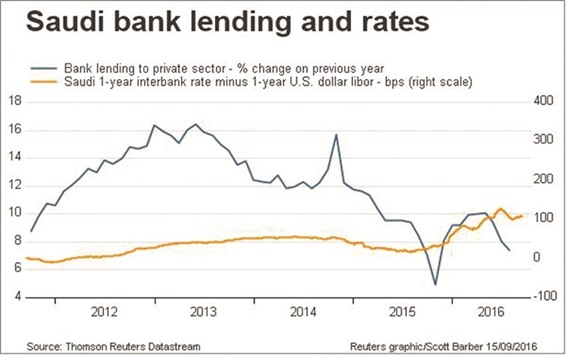Easier lending rules and direct cash injections are doing little to alleviate a cash shortage at Saudi Arabian banks, now at its worst since the financial crisis.
The government is seeking to plug a hole in its finances by withdrawing deposits and selling local currency bonds to lenders in monthly auctions. The country, grappling with lower oil prices, raised 98bn riyals ($26bn) from bond sales to domestic institutions last year, with that figure probably set to rise to about 120bn riyals in 2016, according to Saudi Fransi Capital.
That’s draining funds from the system, reflected in interbank rates in Saudi Arabia that are at their highest since 2009. In addition, the loan-to-deposit ratio has exceeded central bank limits for two months, even after the country boosted the percentage of its deposits that a bank can lend earlier this year.
“The authorities are struggling to find an effective way to boost liquidity,” Asim Bukhtiar, the head of research at Saudi Fransi Capital, said by phone from Riyadh on August 30. “Any liquidity injection is just being pulled back out by the monthly government bond issues.”
The three-month Saudi Interbank Offered Rate, a key benchmark used for pricing loans, rose to 2.318% on August 30, its highest since January 2009, according to data compiled by Bloomberg. The Saudi Arabian Monetary Agency increased the limit that banks can lend to the equivalent of 90% of deposits, up from 85%, people with knowledge of the matter said in February. That figure rose to 90.5% in July, according to monthly data released by SAMA, as the central bank is known, even after the regulator offered $4bn to banks in late June, people with knowledge of the matter said.
The kingdom may raise more than $10bn from its first international bond sale in October, people with knowledge of the matter said.
The central bank “is conscious that Saibor has gone up materially and it will increase the cost of funds for local companies and crimp economic growth,” said Anita Yadav, head of fixed income research at Emirates NBD. “They have to do something to manage this liquidity.”
The increase in the loan-to-deposit rate will probably prompt Saudi authorities to increase the limits further, Yadav said, though a planned international bond issue will bring in some money from outside the country and may relieve some of the pressure, she said.
Liquidity conditions in Qatar have improved after the government raised $9bn from an international bond issue, Doha Bank chief executive officer Raghavan Seetharaman said on August 30 in an interview on Bloomberg Markets Middle East.
“Any moves to further ease the loan-to-deposit rate may only improve things for another six months before the banks hit the limit again,” Saudi Fransi’s Bukhtiar said.

